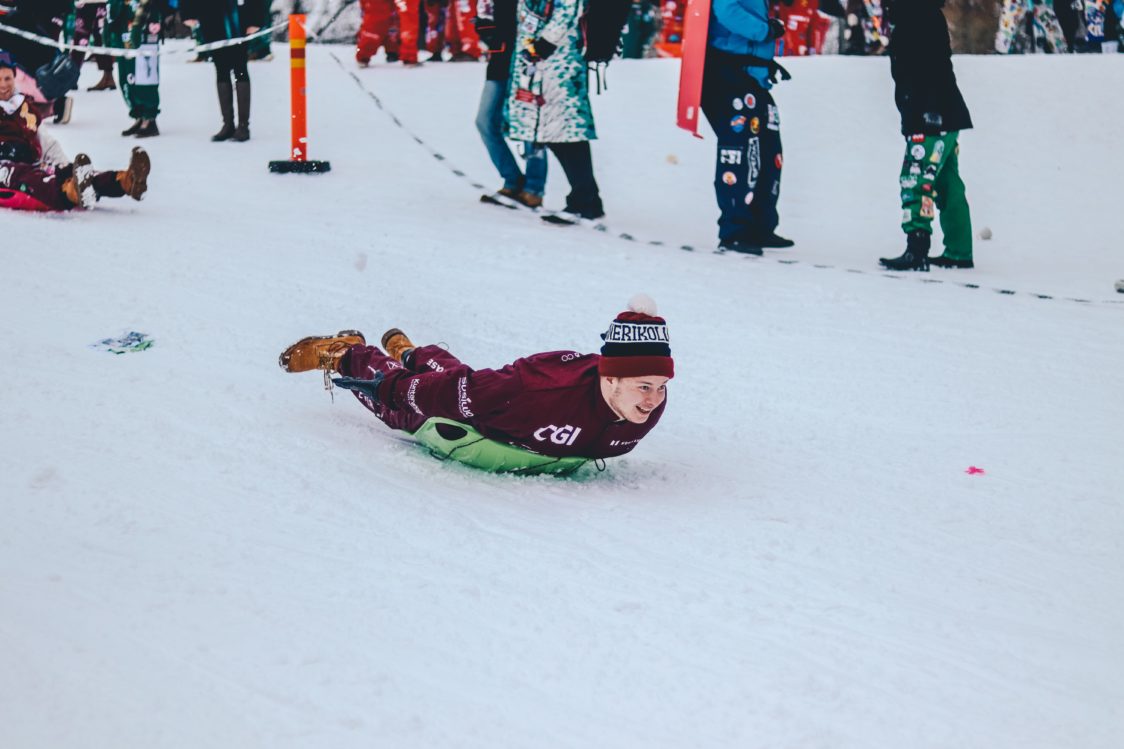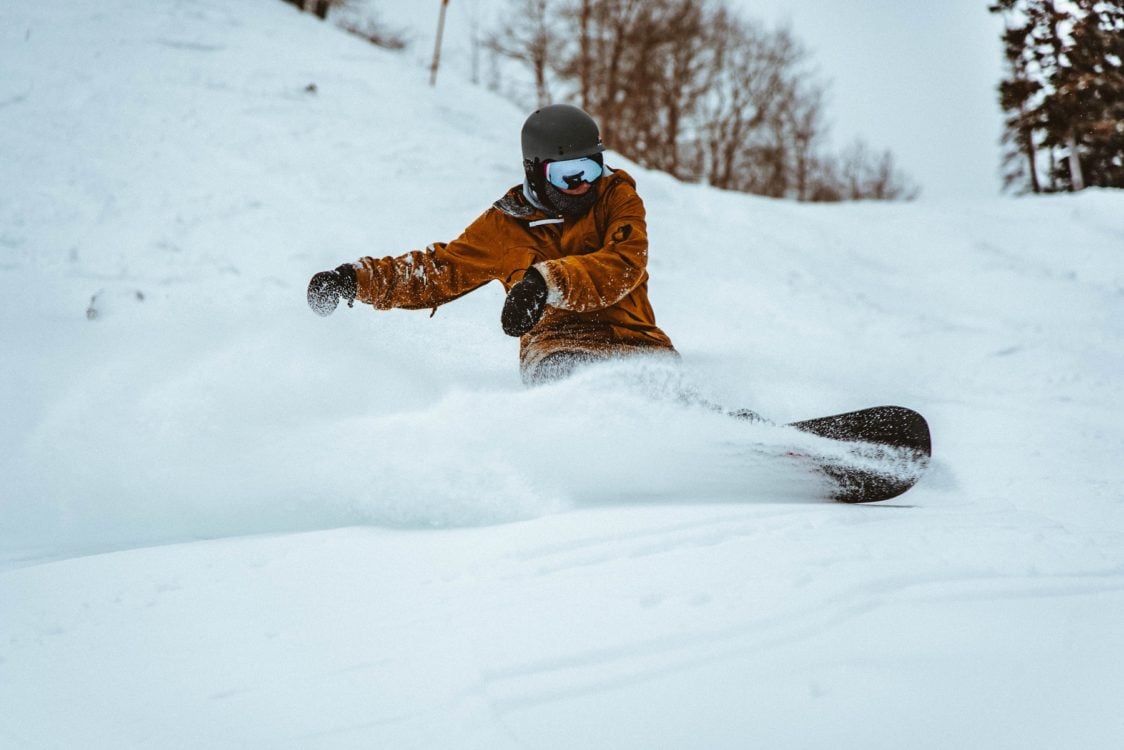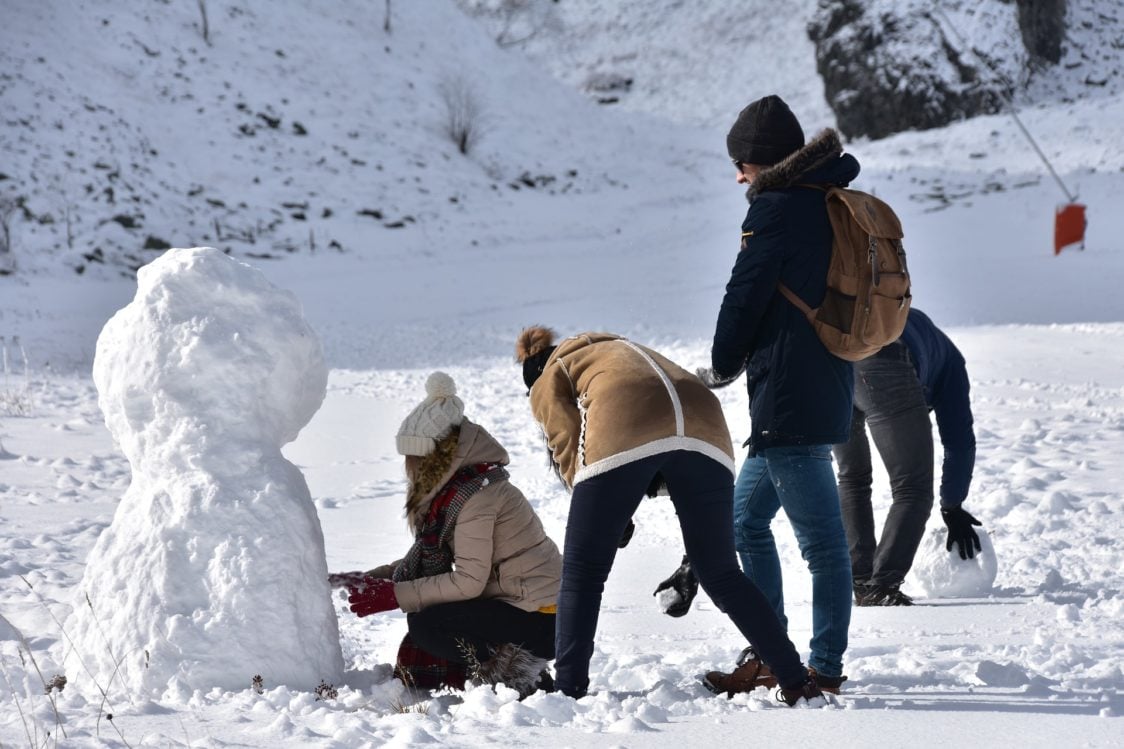Table of Contents
The arrival of the winter months brings out different feelings in each person. Some can’t wait for the snow to finally fall and go skating, skiing or fool around on sleds with younger family members. Others, on the other hand, may be afraid of the colder months because they spend more time at home on the couch, do not play sports outside as much as they do in summer, and slowly begin to suspect that they will gain weight again over Christmas, just as they do every year. But how about trying something a little different this year?
During the Christmas period, most people have more time off than usual thanks to the holidays, and it is up to them to decide how to use this time. But there is no point stressing about gaining weight. You don’t have to spend your holidays just lying on the couch eating Christmas sweets. Try it a little differently this year. In today’s article we bring you tips on activities you can do during the winter months. We will also tell you how many calories you burn undertaking each. You may be surprised at how high the numbers are. If you stay active over Christmas, you don’t have to worry about indulging in the occasional treat and gaining weight.
Why every year in winter do we gain weight?
In winter, as in any other season, the same calorie balance rules apply again. If you take in more calories than your body can burn, you’ll be in caloric excess and gain weight. If it happens to you every year, you’re not alone. The results of a study, which compared more than 1,000 people, showed that each participant gained an average of 1.35% of their body weight over Christmas. A 65 kg woman would gain less than 0.9 kg, and an 80 kg man would gain approximately 1.1 kg. [3-5]
An increase in body fat percentage in winter can occur due to several factors
1. You indulge in too much Christmas baking and high calorie foods
Nobody is saying to avoid Christmas treats like the devil, but it is good to have some idea of how many calories the delicacies you eat whilst watching Christmas films have. Did you know that 100 g of Christmas gingerbread has approximately 370 kcal and 100 g of chips about 530 kcal? Hand on your heart, does it happen that you often don’t really know how much you’ve eaten while watching a thrilling film plot? You’re probably not the only one. According to the results of a study, the number of people with stroke deaths and other heart problems significantly increases during Christmas. And it’s no secret that these problems are common among overweight and obese people. [2]
If you feel that Christmas overeating is a problem, mindfulness eating, or conscious eating, might be the ideal solution for you, where you try to focus only on the food you consume, perceive its taste and texture, making you aware of how much you have actually eaten. If you eat this way, you probably won’t happen to overeat. Try eating up to 80% of the feeling of saturation because it takes the body a while to realize that it is full. [1]

2. You drink caloric drinks
If you’re not lured by sweets or chips, maybe you’re more attracted to drinks that you don’t even realize are calorific.
To give you an idea:
- mulled wine – 200 ml has approximately 210 kcal
- punch – 200 ml has approximately 130 kcal
- bombardino – one serving can have approximately 450 kcal
- mead (honey-wine) – 200 ml has approximately 191 kcal
- gingerbread latte – the average size is approximately 260 kcal
These numbers are only indicative, if you add more sugar, they may be even higher. As you can see, calories from drinks can jump up quickly and more subtly than calories from food. But even these can be the reason why you gain a few kilos every winter.
3. You undertake less physical activity in winter, but you don’t adjust your stance towards this
Forcing yourself to play sports in winter can be much more challenging than in summer, when it’s warm outside, the sun is shining and you’re just drawn to be outside. You may even feel that you can’t do as many activities in winter as during the warmer months, so you’re less active, which will be reflected in your weight, unless you adjust your diet. If lack of exercise is your problem in winter, try to get inspiration from the following activities that you can do during the winter months. And if you’re honest with yourself, you don’t have to worry about gaining weight from gingerbread or mulled wine.
You might be interested in these products:
The top 11 winter activities which burn the most calories
The activities you can undertake in winter are plentiful. We’ve selected 11 of them for you to show you how many calories a 65 kg woman and an 80 kg man can burn in an hour of active exercise. These values are indicative only and will vary for each on the basis of intensity and other factors. The estimates are based on the coefficients of Compendium of Physical Activities given for the activities. [10]
1. Skating
Skating on a pond or ice rink can look easy at first glance, but only until you first set foot on the ice. If you’ve tried roller skating, maybe learning this sport will be easy for you. Otherwise, we recommend using knee pads at the very least. You probably can’t help falling at first, but then you will see how challenging for your body it is. Your leg joints will receive a great workout thanks to maintaining your balance whilst you’re skating. If you can’t do it at first, don’t despair and be patient. Because the feeling of whooshing around on a pond and enjoying nature in winter is well worth it. You should also try the local ice rink.
How many calories do you burn on average by skating for an hour at 14.5 km/h? [10]
- A woman weighing 65 kg burns approximately 358 kcal.
- A man weighing 80 kg burns approximately 440 kcal.
2. Ice Hockey
Ice hockey ranks amongst one of those activities that are physically very demanding. With maximum effort, one can soon exhaust oneself, so it is not surprising that even during a match there is frequent rotation on the ice. A successful hockey player must practice using short bursts of energy in order to be able to ideally shoot a goal. If you start playing hockey, you can’t expect to burn the same amount of calories as hockey players in games from the first instance. Equally, it must be kept in mind that only the calories burned by active play time counts, if you sit out the entire game on the bench, you cannot compare the number of calories burnt to players on the ice.
On average, how many calories do you burn playing hockey for an hour? [10]
- A woman weighing 65 kg burns approximately 565 kcal.
- A man weighing 80 kg burns approximately 700 kcal.
3. Sledding
You may feel that this sport is no longer for adults, but the opposite is true. Sledding is not only awesome fun, but also an activity that burns a lot of calories. Little kids may not even realize they run up a hill 30 times during the afternoon sledding. Nowadays you can think of it as a HIIT workout, where you can run up the hill with the sled with the utmost effort and take a short rest and then enjoy a fast ride back down the hill. And if you feel like you look crazy to those around you being alone on a sled, head up the hill with the kids. You can of course take friends, you will see that you will enjoy an active afternoon full of fun during sledding, bobsleigh or shovel racing.
On average, how many calories do you burn by sledding for an hour? [10]
- A woman weighing 65 kg burns approximately 455 kcal.
- A man weighing 80 kg burns approximately 560 kcal.

4. Skiing
Skiing is one of the most popular winter sports, so you can meet skiers just about any age on the slopes. However, skiing can be approached in many ways and the number of calories you burn depends on this. If you take it responsibly, standing majority of the time at the turnstiles, and you don’t come back down the slope until the lifts are standing still for the day, you burn a significant number of calories per day beyond your basal metabolism, but it may still not be as much as you’d expect.
According to calculations based on the most accurate coefficients we find that a 65 kilo woman burns approximately 345 kcal per hour of skiing downhill. But we certainly can’t count on this woman burning 2415 kcal in the seven hours she’s been on the slope. They spend at least an hour having lunch, a break for snacks or drinks. We have six hours left. The average chairlift ride up the hill can take up to 20 minutes, when you just sit and wait for your descent down. And what does that mean? Therefore, out of six hours of “skiing” our skier spends 4 hours sitting on the chair and only two hours of the whole day actively skiing, which could burn approximately 690 kcal. But if she rode the tow where she would be standing, the calories burnt would be a little higher.
If our skier then decides to enjoy two bombardinos on the slope, which would have a total of 900 kcal, then the burnt energy and something more will be added. Plus if you’re one of those people who commemorates every ride with a mulled wine or a small snack and goes up the slope predominantly to chat with friends or catch bronze on the deck chairs at the bottom of the slope, then there’s no point in worrying too much about burning calories.
How many calories do you burn on average with an hour of active downhill skiing? [10]
- A woman weighing 65 kg burns approximately 345 kcal.
- A man weighing 80 kg burns approximately 424 kcal.
5. Snowboarding
The same applies to snowboarding as to skiing. If you have read somewhere about how you have a massive energy expenditure when snowboarding and burn up to hundreds of calories per hour, you need to take into account that you spend most of your time sitting on the chairlift.
How many calories do you average with an hour of active snowboarding? [10]
- A woman weighing 65 kg burns approximately 345 kcal.
- A man weighing 80 kg burns approximately 424 kcal.

6. Cross country skiing
Compared to downhill skiing, cross-country skiing has the advantage that you usually don’t have to deal with active time, as you are really on the move the whole time you have cross-country skis on your feet. This activity is ideal especially for those who are tired of being in the same place all the time in the mountains and want to explore their surroundings. Once you’ve learnt to cross-country ski, you’ll see that you fall for this activity. In addition, thanks to it, you will burn a relatively large number of calories because you are using each part of your body. You can then reward yourself with Christmas treats.
How many calories do you burn on average with an hour of cross country skiing at 4 km/h? [10]
- A woman weighing 65 kg burns approximately 442 kcal.
- A man weighing 80 kg burns approximately 544 kcal.

7. Running
You would like to go cross country skiing, but there’s no snow? At the very least take up classic running for now and don’t be discouraged by the cold. Thanks to this activity you will burn calories, and also improve your health and physique. You will benefit from this in other physical activities, not only in winter sports.
But don’t forget to get dressed well so you don’t get too cold and come down with tonsillitis. Hats and warm socks are essential. And you shouldn’t forget reflective elements in the winter months. [6-9]
How many calories do you burn on average with an hour’s running at 8 km/h? [10]
- A woman weighing 65 kg burns approximately 540 kcal.
- A man weighing 80 kg burns approximately 660 kcal.
8. Snowshoe walking
If you’re afraid of winter sports, you don’t enjoy them or for any other reason you can’t find your way to them, how about a brisk snowshoe walk? This activity can be a pleasant change from conventional walking, and it is even more demanding because of walking through the snow.
On average, how many calories do you burn walking in snowshoes for an hour? [10]
- A woman weighing 65 kg burns approximately 350 kcal.
- A man weighing 80 kg burns approximately 430 kcal.
9. Snowball Fighting
Again, another activity, where by your involvement you will especially please all the children. If you take a snowball fight as a way of burning calories, it’s not enough just to stand still and count the number of times you get hit. Engage actively. Dodge, jump, run, and if someone hits you with a snowball, run as fast as you can behind them to repay them. You’ll see that an hour of snowballing flies fast, and you can add a few hundred more to your burnt calorie count.
On average, how many calories do you burn by snowball fighting for an hour? [10]
- A woman weighing 65 kg burns approximately 400 kcal.
- A man weighing 80 kg burns approximately 505 kcal.
10. Building a snowman
What else can you do with snow? Well, build a snowman. Although the amount of calories burned won’t be as great as, say, running, it certainly counts. In addition, you can also be rewarded with a masterpiece in the form of a snowman standing in front of your house, which will be admired by all passers-by.
How many calories do you burn building a snowman? [10]
- A woman weighing 65 kg burns approximately 260 kcal.
- A man weighing 80 kg burns approximately 320 kcal.

11. Shoveling snow
The last activity that many people can’t avoid during the winter is shoveling snow. But you may be pleased to find out how many calories you can burn with this activity. If you put your weight into it, you’ll see that you can really give your body a workout.
On average, how many calories do you burn by intensively shoveling snow for an hour? [10]
- A woman weighing 65 kg burns approximately 570 kcal.
- A man weighing 80 kg burns approximately 705 kcal.
What should you remember?
The winter months do not at all costs have to be a time of weight gain or an increase in body fat percentage. It’s up to you how you approach it. Even if you want to relax during the winter holidays, try to include at least some physical activity daily. You don’t necessarily have to spend all day cross-country skiing. Sometimes you can go for a walk, sweep away the snow or enjoy a good snowball fight. As long as you are physically active, you don’t have to worry if you indulge in a sweet or even a classic Christmas snack. But keep in mind that there are calories in drinks as well as in food, so it is a good idea to have an overview of what you eat and drink in a day.
Well, if you do gain a little weight over Christmas, that’s fine. Holidays aren’t about how much a person weighs. The most important thing is that you enjoy quality time with your loved ones. Starting in the New Year, you can ease back into it nicely and lose any extra kilos.
Do you try to be active over the holidays, or do you prefer to lie down and watch Christmas films and start working on your physical activity in the new year? Share your favourite activities in winter. And if you liked the article, don’t forget to share it with your friends. Maybe thanks to them you’ll find takers for the first winter snowball fight.
[1] Mantzios – Mindfulness, Eating Behaviours, and Obesity: A Review and Reflection on Current Findings – https://link.springer.com/article/10.1007/s13679-014-0131-x
[2] Phillips – Cardiac mortality is higher around Christmas and New Year's than at any other time: the holidays as a risk factor for death – https://pubmed.ncbi.nlm.nih.gov/15596560/
[3] Casazza a kol. – Myths, presumptions, and facts about obesity. – https://doi.org/10.1056/NEJMsa1208051
[4] Guyenet, S. J., & Schwartz, M. W. – Regulation of Food Intake, Energy Balance, and Body Fat Mass: Implications for the Pathogenesis and Treatment of Obesity. – https://doi.org/10.1210/jc.2011-2525
[5] Turicchi a kol. – Weekly, seasonal and holiday body weight fluctuation patterns among individuals engaged in a European multi-centre behavioural weight loss maintenance intervention – https://pubmed.ncbi.nlm.nih.gov/32353079/
[6] Centers for disease control and prevention Atlanta – Physical Activity for a Healthy Weight – https://www.cdc.gov/healthyweight/physical_activity/index.html
[7] Friedenreich, Orenstein (2002) – Physical Activity and Cancer Prevention: Etiologic Evidence and Biological Mechanisms – https://doi.org/10.1093/jn/132.11.3456S
[8] Pedersen, Bruunsgaard (1995) – How physical exercise influences the establishment of infections – https://pubmed.ncbi.nlm.nih.gov/7676100/
[9] Campbell, Turner – Debunking the Myth of Exercise-Induced Immune Suppression: Redefining the Impact of Exercise on Immunological Health Across the Lifespan – https://pubmed.ncbi.nlm.nih.gov/29713319/
[10] Compendium of physical activities – https://sites.google.com/site/compendiumofphysicalactivities/Activity-Categories/winter-activtities


Add a comment